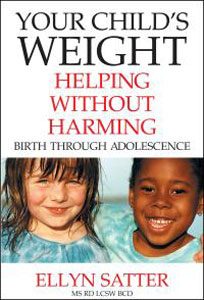

Family Meals Focus
The Ellyn Satter Institute Newsletter
Big babies do not become obese adults
by Ellyn Satter, Registered Dietitian and Family Therapist
Some people are just big, from birth. But big does not equal obese, overweight, too fat, or any other word used to describe unusually high body weight. Children grow in the way that is right for them. As long as a child’s weight follows consistently along a given percentile, even if it is high, s/he is just fine. If you have a big child, particularly if you are big yourself, your task is is the same as that of any other parent: To do a good job with feeding by following the division of responsibility. Follow a division of responsibility with activity, as well. Then trust your child to eat, move, and grow in the way that is right for her.
Two interpretations of the same data
The conventional approach is based on control: Keeping children from exceeding a certain, predetermined size. From that perspective, current research raises alarms about infant antecedents of overweight, and puts pressure on health professionals and parents to impose early restriction. With that in mind, consider these bits of data as reported from the conventional, control approach. Just over 5% of almost 28,000 infants plot at or above the 95th percentile by age 7. Those who grow rapidly as infants are about 1.5 times likelier to reach the 95th percentile.1 Infants who grow faster during the first week and the first four months tend to be above average in size (>BMI 25) as adults.2,3 From the conventional, policy-driven perspective, any child who plots at or over the 85th percentile is overweight; a child who plots at or over the 95th percentile is obese and something should be done about it..
From the feeding dynamics perspective, the trust perspective, this is interesting data that describes normal growth. From a statistical point of view, you would expect 5% of children to plot at the 95th percentile or higher. Babies who start out big and/or grow fast tend to be big later on. That’s to be expected, it’s normal, and it’s good to have confirmation. The task is to support parents in feeding well and trusting children to grow in the way that is right for them.
What about big babies who have big mothers?
The leading cause of weight acceleration is food restriction, generally precipitated by misinterpretation of normal growth.
Babies of big mothers are said to be at risk of obesity. However, until age 2 years, with respect to size, fatness and growth velocities, there are no differences between infants of high-BMI (>30) and low-BMI (<20) mothers. The possible exception is that infants of high-BMI mothers may eat more enthusiastically, with more sucks per minute.4 By age 3.5 and 6 years of age, 15% of children reach BMIs at or above the 85th percentile, which is to be expected statistically.5 This concerns the conventional folks, who diagnose overweight at that percentile level. It does not concern the trust folks, who say that some children are just relatively big.
Obesity diagnoses are arbitrary
BMI measures body density, which tracks, not body fat, which doesn’t.6 Five percent of children normally plot at the 95th percentile and above, 15% at the 85th percentile and above.7 Children’s growth naturally adjusts over about the first 7 years, large infants of small parents gradually become smaller, and vice versa.8 Adults are classified as obese when their BMI is 30 or over. If we had growth charts for adults similar to those for children, BMI 30 would plot at the 75th percentile.9 Which means that adults are diagnosed as obese when their weight is at even lower levels than for children. People can leave childhood at “normal” weight and enter adulthood “obese.” It is a crazy-making numbers game. Since the bar gets lower as people get older, it is little wonder that big infants get classified as obese when they are adults!
Pathologizing normal weight does great harm
These entertaining observations about normal size and growth become ominous when addressed with conventional thinking. In accordance with health policy, relatively large size is labeled as overweight or obese. Regardless of their size, children of relatively large parents are labeled as at risk of obesity. This pathologizing leaves parents vulnerable to patterns that have been clearly demonstrated to make children fatter: perceiving their child as overweight, being concerned about it, and restricting their child’s food intake.10,11
What gets missed: Children whose weight goes up too fast
One of the studies broke new ground in following the children’s growth longitudinally and identifying a subgroup of four children whose weight rapidly accelerated.5 An additional study could examine those four children in detail to determine what disrupted their growth. Evidence-based clinical observations show that the leading cause of weight acceleration is food restriction precipitated by misinterpretation of normal growth.
Raise children to get bodies that are right for them
To avoid misinterpreting normal growth as overweight, the feeding dynamics approach defines normal growth as consistent longitudinal growth at any percentile. To support that consistent growth, optimize feeding from birth by following the division of responsibility in feeding. Target children for assessment and problem solving only when their weight shows abrupt and considerable acceleration.
References
1. Stettler N, Zemel BS, Kumanyika S, Stallings VA. Infant weight gain and childhood overweight status in a multicenter, cohort study. Pediatrics. 2002;109:194-199.
2. Stettler N, Kumanyika SK, Katz SH, Zemel BS, Stallings VA. Rapid weight gain during infancy and obesity in young adulthood in a cohort of African Americans. Am J Clin Nutr. 2003;77:1374.
3. Stettler N, Stallings VA, Troxel AB, et al. Weight Gain in the First Week of Life and Overweight in Adulthood: A Cohort Study of European American Subjects Fed Infant Formula. Circulation. 2005;111:1897-1903.
4. Stunkard AJ, Berkowitz RI, Schoeller D, Maislin G, Stallings VA. Predictors of body size in the first 2 y of life: a high-risk study of human obesity. Int J Obes Relat Metab Disord. 2004;28:503-13.
5. Berkowitz RI, Stallings VA, Maislin G, Stunkard AJ. Growth of children at high risk of obesity during the first 6 y of life: implications for prevention. Am J Clin Nutr. 2005;81:140-146.
6. Wright CM, Parker L, Lamont D, Craft AW. Implications of childhood obesity for adult health: findings from thousand families cohort study. British Medical Journal. 2001;323(7324):1280-1284.
7. Satter EM; Chapter 10, Understand Your Child’s Growth. Your Child’s Weight: Helping Without Harming . Madison, WI: Kelcy Press; 2005:323-380 .
8. Falkner F, Tanner JM, Editors; Human Growth. Tanner JM. Growth As a Target-Seeking Function: Catch-Up and Catch-Down Growth in Man. Second Edition ed. New York and London: Plenum; 1986:167-179.
9. Najjar MF, Rowland M; Anthropometric reference data and prevalence of overweight, United States, 1976-80. Vital and Health Statistics, National Center for Health Statistics. Washington, D.C.: U.S. Government Printing Office; 1987;Series 11: No. 238; DHHS Pub. No. (PHS) 87-1688.
10. Faith MS, Berkowitz RI, Stallings VA, Kerns J, Storey M, Stunkard AJ. Parental Feeding Attitudes and Styles and Child Body Mass Index: Prospective Analysis of a Gene-Environment Interaction. Pediatrics. 2004;114:e429-436.
11. Faith MS, Scanlon KS, Birch LL, Francis LA, Sherry B. Parent-Child Feeding Strategies and Their Relationships to Child Eating and Weight Status. Obes Res. 2004;12:1711-1722.
Explore
For more information for parents about normal growth and protecting themselves against interference, see Your Child’s Weight: Helping Without Harming .
Address weight wisely and well
- Avoid restriction
- Children know how much they need to eat
- Follow Satter’s Division of Responsibility in Feeding(sDOR)
- Raise a healthy child who is a joy to feed
- Resolve the weight dilemma
Related issues of Family Meals Focus
- Baby-led weaning
- Big baby, big parents: No problem!
- Breastfeeding hullabaloo
- Catchup growth: Normal for premature babies
- Early infant weight gain, obesity, and adult disease
- Feeding in your baby’s first year
- Pureed food in pouches: boon or bane?

